Street art plays a crucial role in reflecting cultural shifts and societal issues. This article explores its evolution from graffiti to diverse art forms, examines various techniques like stenciling and murals, and highlights its cultural significance in urban environments. Additionally, it addresses the legal implications surrounding street art and its influence on mainstream culture and community engagement. Finally, it discusses emerging trends such as digital integration and sustainable practices in the street art movement.
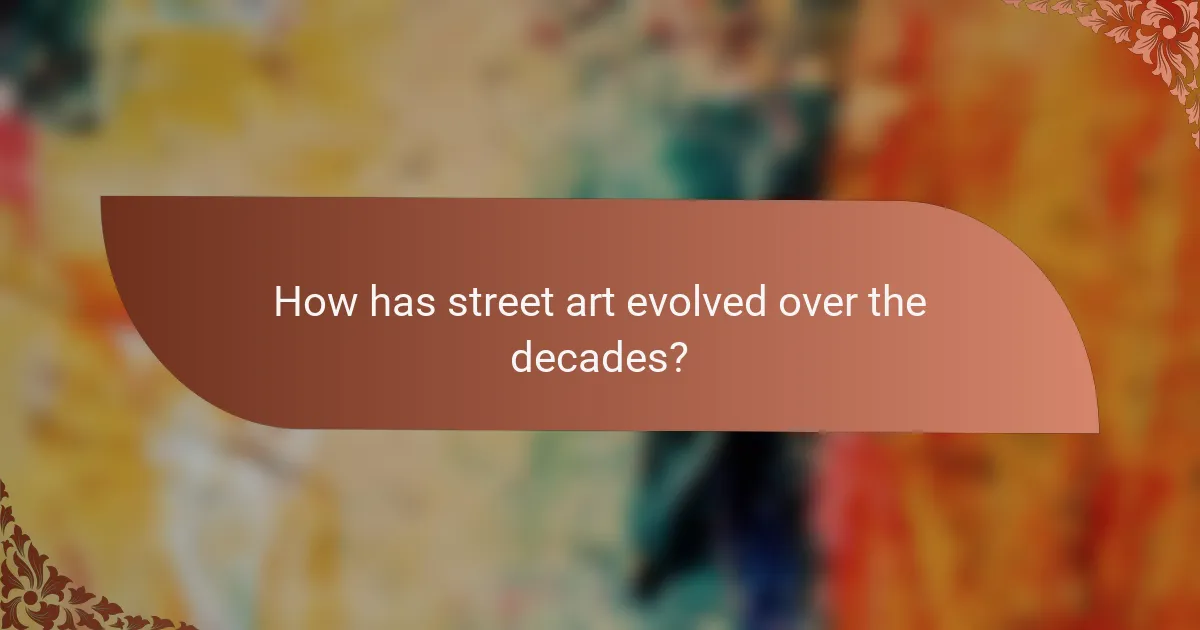
How has street art evolved over the decades?
Street art has evolved significantly over the decades, reflecting cultural shifts and technological advancements. Initially rooted in graffiti, it has transformed into a diverse art form encompassing murals, installations, and digital expressions.
In the 1980s, street art was primarily associated with urban graffiti, often conveying political messages. The 1990s saw the rise of artists like Banksy, who introduced satirical and socially conscious themes. By the 2000s, street art gained mainstream recognition, with galleries showcasing urban artists.
Today, street art incorporates various techniques, including stenciling, wheat-pasting, and augmented reality. This evolution highlights its cultural significance as a medium for social commentary and community engagement. Street art now serves as a platform for diverse voices, challenging traditional art narratives.
What key movements have influenced street art’s development?
Street art has evolved through various movements, including graffiti, pop art, and social activism. Graffiti emerged in urban environments, emphasizing self-expression and identity. Pop art integrated commercial imagery, broadening street art’s appeal. Social activism introduced political themes, making art a platform for change. These movements collectively shaped street art’s cultural significance and techniques.
How do cultural and political contexts shape street art?
Cultural and political contexts significantly shape street art by influencing its themes, styles, and acceptance. Street art often reflects societal issues, acting as a medium for political expression and cultural commentary. For example, in regions with political repression, street art may serve as a form of resistance and protest. In contrast, areas with supportive environments for artists may see more diverse and experimental forms of expression. The evolution of street art is closely tied to the cultural significance it holds within different communities, impacting its techniques and visibility.
Which iconic street artists have defined the genre?
Banksy, Jean-Michel Basquiat, Shepard Fairey, and Keith Haring are iconic street artists who have defined the genre. Each artist brought unique styles and messages, influencing street art’s evolution and cultural significance.
Banksy is known for his satirical and politically charged works, often featuring stenciled images. Jean-Michel Basquiat’s raw and expressive style combined graffiti with neo-expressionism, addressing social issues. Shepard Fairey gained fame for his “Obey Giant” campaign and the iconic “Hope” poster of Barack Obama, blending art with activism. Keith Haring’s vibrant and playful imagery often conveyed messages of love and social justice, making art accessible to the public.
These artists have shaped street art, pushing boundaries and challenging societal norms through their distinctive approaches. Their contributions continue to inspire new generations of artists worldwide.
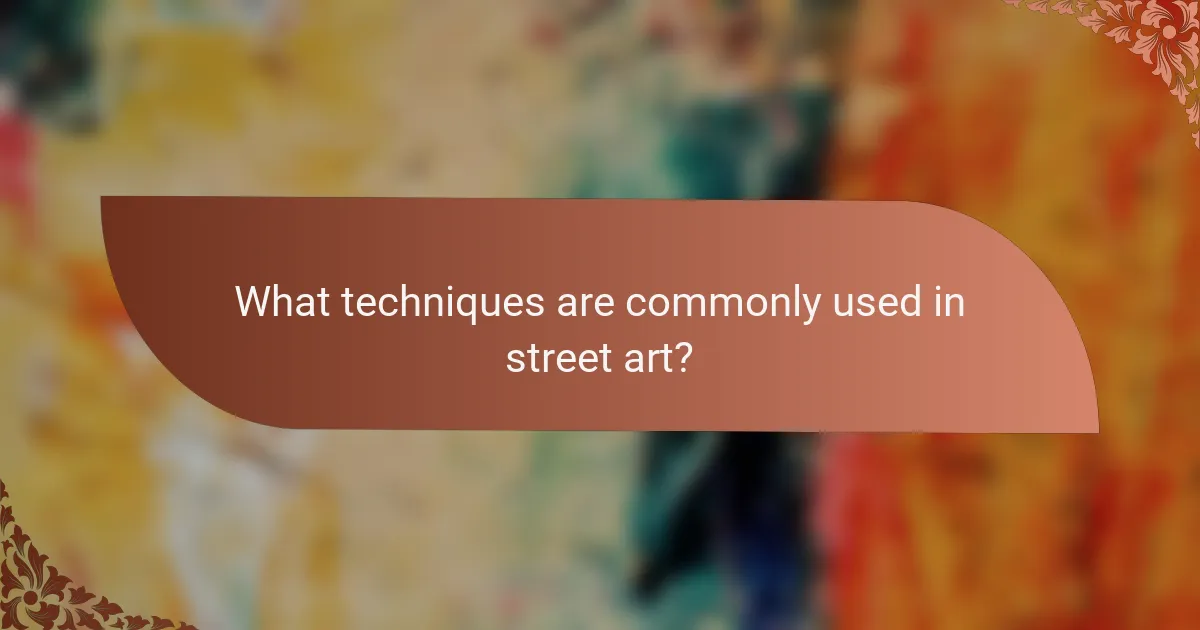
What techniques are commonly used in street art?
Street art techniques include stencils, spray painting, murals, wheatpasting, and installations. Each technique offers unique ways to express creativity and engage with public spaces.
Stencils allow for quick replication and intricate designs, while spray painting provides vibrant colors and fluidity. Murals often cover large surfaces, making bold statements. Wheatpasting involves adhering printed materials to walls, creating a collage effect. Installations can incorporate various materials and dimensions, transforming environments.
These techniques reflect the evolution of street art, showcasing diverse styles and cultural significance.
How do different mediums affect the outcome of street art?
Different mediums significantly influence the outcome of street art by affecting its visibility, texture, and interaction with the environment. For instance, spray paint allows for vibrant colors and quick application, while stencils enable precision and reproducibility. Murals painted on walls create large-scale impacts, whereas chalk art offers temporary displays that invite community interaction. Digital projections can transform public spaces dynamically, adapting to different contexts. Each medium carries unique attributes that shape the artistic expression and cultural significance of the work.
What role does technology play in modern street art creation?
Technology plays a crucial role in modern street art creation by enhancing artistic expression and accessibility. Digital tools like graphic design software allow artists to experiment with designs before painting. Augmented reality applications enable interactive experiences, merging the physical and digital realms. Moreover, social media platforms help artists promote their work and connect with audiences globally. The use of spray paint and stencils has evolved with the introduction of digital projection techniques, allowing for precise designs and larger murals. This integration of technology not only expands the creative possibilities but also elevates street art’s cultural significance in contemporary society.
Which tools are essential for street artists today?
Essential tools for street artists today include spray paint, stencils, brushes, markers, and digital devices. Spray paint remains the primary medium for vibrant murals, while stencils offer precision and speed. Brushes and markers allow for detailed work and touch-ups. Digital devices, such as tablets and design software, enable artists to plan and visualize their creations before execution. These tools reflect the evolution of street art, merging traditional techniques with modern technology.
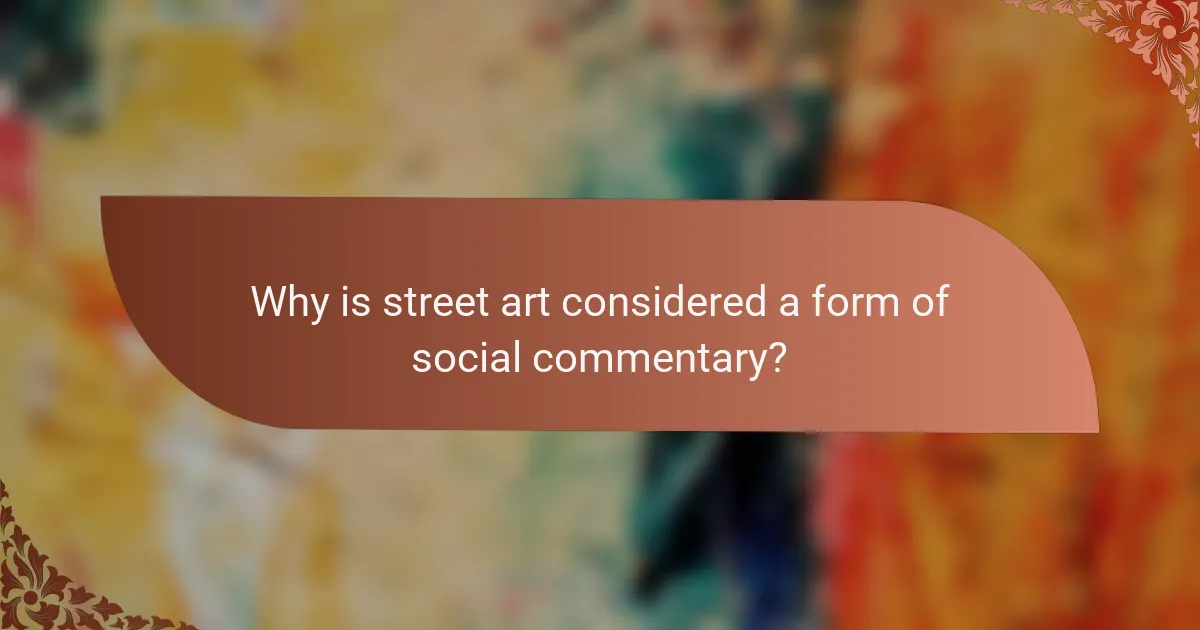
Why is street art considered a form of social commentary?
Street art is considered a form of social commentary because it often addresses societal issues, challenges norms, and provokes thought. Artists use public spaces to express dissent, raise awareness, and inspire dialogue. This medium allows marginalized voices to be heard and can reflect cultural, political, and economic contexts. Unique attributes of street art include its accessibility and ephemeral nature, which enhances its impact on communities.
How does street art reflect community identity and values?
Street art reflects community identity and values by expressing local culture, social issues, and collective sentiments. It serves as a visual dialogue, showcasing the unique perspectives of its artists and the communities they represent. For example, murals often depict historical events or figures significant to the area, fostering a sense of pride and belonging. Additionally, street art can address social injustices, acting as a catalyst for conversation and change within the community. This dynamic interplay between art and community values highlights the evolving nature of public spaces and their role in shaping identity.
What are the reactions of local authorities to street art?
Local authorities often have mixed reactions to street art, ranging from support to opposition. Some view it as a form of cultural expression that enhances urban spaces, while others see it as vandalism. Supportive authorities may promote street art festivals or grant permits for murals, recognizing their ability to attract tourism and foster community engagement. Conversely, cities may implement strict regulations or remove unauthorized works, prioritizing public property preservation. This duality reflects the evolving perception of street art’s role in society.
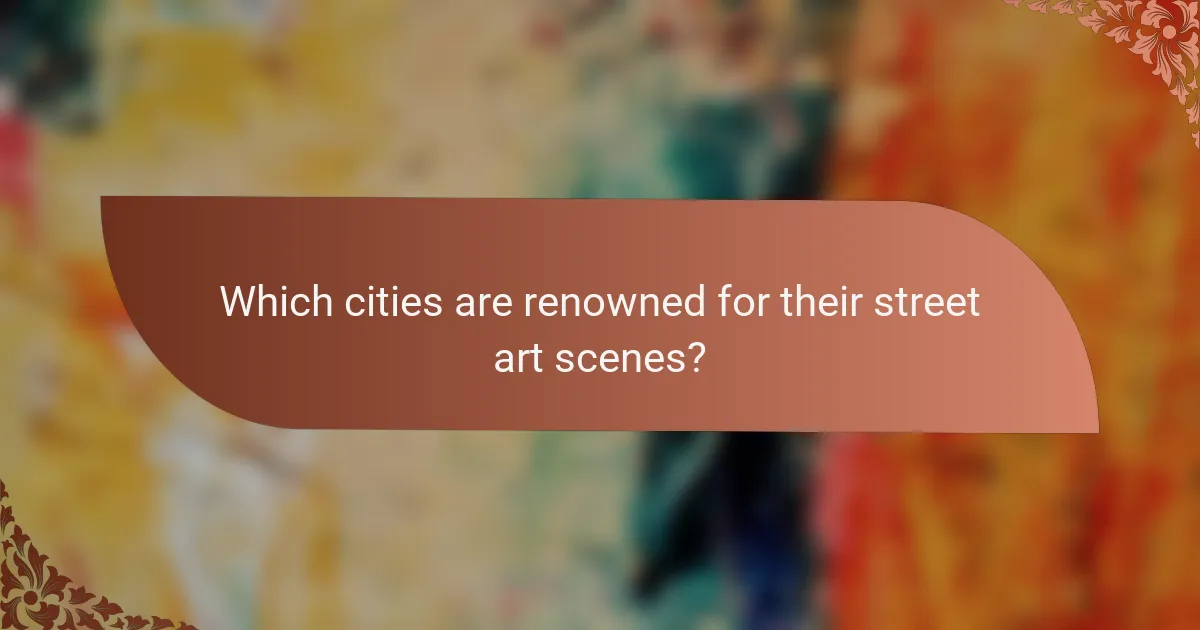
Which cities are renowned for their street art scenes?
Cities renowned for their street art scenes include Berlin, New York, and Melbourne. These urban areas showcase vibrant murals and graffiti, reflecting cultural narratives and artistic expression.
Berlin is famous for its politically charged art, particularly the East Side Gallery. New York boasts iconic neighborhoods like Bushwick, where murals cover entire buildings. Melbourne’s laneways, such as Hosier Lane, are filled with ever-changing street art, attracting both locals and tourists.
Other notable cities include São Paulo, known for large-scale murals, and Paris, where street art blends with historical architecture. Each city contributes uniquely to the global street art movement.
How do street art festivals contribute to local culture?
Street art festivals significantly enhance local culture by fostering community engagement and artistic expression. These events bring together diverse artists, creating a platform for cultural exchange and collaboration.
They often showcase local talent, reflecting the unique identity of the area. This representation strengthens community pride and attracts tourism, which boosts the local economy. Festivals can also address social issues through art, sparking dialogue and awareness among residents.
Moreover, street art festivals contribute to urban revitalization, transforming neglected spaces into vibrant public art galleries. This beautification enhances the aesthetic appeal of neighborhoods, making them more inviting for residents and visitors alike.
In summary, street art festivals play a crucial role in enriching local culture by promoting creativity, community bonding, and economic growth.
What impact does tourism have on street art in urban areas?
Tourism enhances street art in urban areas by increasing visibility and attracting diverse artists. It fosters cultural exchange, leading to innovative techniques and styles. As a result, cities often see a rise in commissioned works that cater to tourists, blending local culture with global influences. This interaction creates a vibrant urban landscape, enriching the cultural significance of street art.
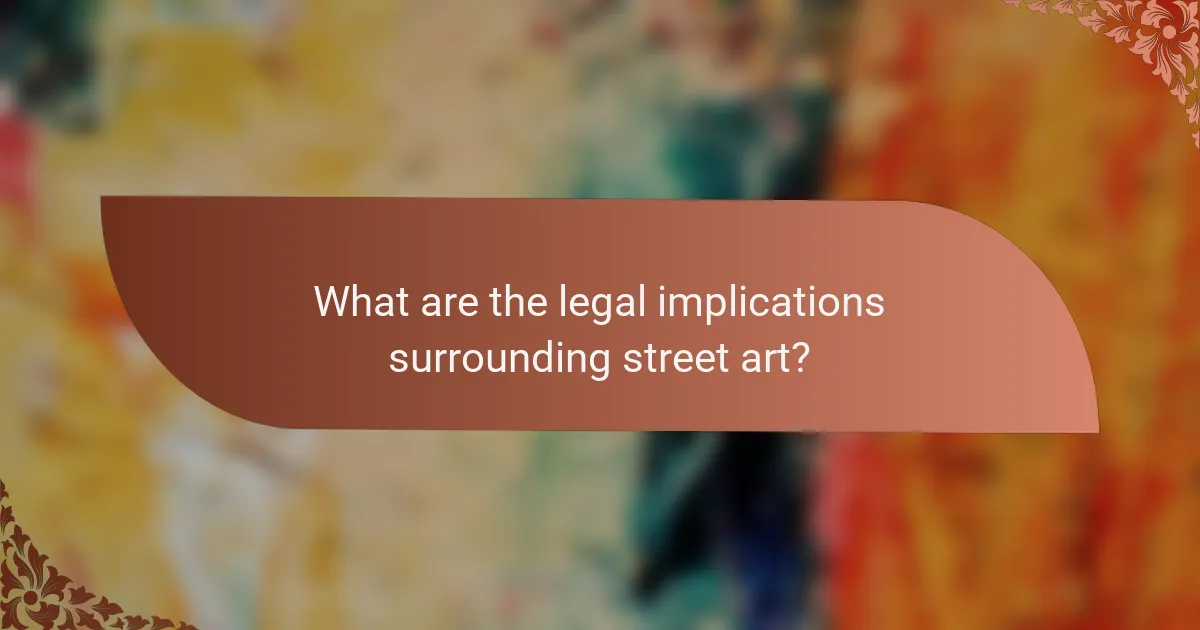
What are the legal implications surrounding street art?
Street art often exists in a legal gray area, leading to potential implications for artists and property owners. Unauthorized street art can result in vandalism charges, while commissioned works may raise copyright issues. Local laws vary significantly, impacting the recognition and protection of street art as a legitimate form of expression. Some cities have enacted policies to support street artists, offering legal walls or permits, which can enhance the cultural significance of the art. Legal considerations also intersect with urban development, as street art can influence gentrification and community identity.
How do copyright laws affect street artists?
Copyright laws significantly impact street artists by restricting their ability to use existing works without permission. These laws can limit creativity and expression, as artists must navigate legal boundaries to avoid infringement.
Street artists often face challenges in asserting their rights over their own work, especially if it is placed in public spaces. The unique attribute of street art is its ephemeral nature, which complicates copyright claims. Additionally, the cultural significance of street art as a form of social commentary can clash with strict copyright regulations.
As a result, many street artists advocate for clearer guidelines that recognize their contributions while balancing the rights of original creators. This ongoing dialogue reflects the evolving relationship between art and law in contemporary society.
What are common legal challenges faced by street artists?
Street artists commonly face legal challenges such as vandalism charges, copyright infringement, and disputes over public space usage. These issues arise from the often-unregulated nature of street art. Local laws may classify street art as graffiti, leading to potential fines or arrest. Additionally, artists may encounter conflicts with property owners regarding permission and ownership rights. These legal hurdles can stifle creativity and limit the cultural impact of street art.

How does street art influence mainstream culture?
Street art significantly influences mainstream culture by challenging norms and sparking conversations. It serves as a platform for social commentary, often addressing political and social issues. The vibrant visuals and innovative techniques used in street art attract public attention, leading to increased visibility for artists and their messages.
As street art gains acceptance, it infiltrates various media, including fashion, advertising, and music. Collaborations between street artists and brands illustrate this trend, merging artistic expression with commercial appeal. This evolution highlights street art’s role in shaping contemporary aesthetics and cultural dialogues.
Moreover, street art fosters community engagement, encouraging public participation in the arts. Murals and installations often reflect local identities, promoting a sense of belonging and pride. This unique attribute of street art distinguishes it from traditional art forms, making it a dynamic force in cultural landscapes.
Overall, street art’s impact on mainstream culture is profound, as it continues to redefine artistic boundaries and inspire new generations of creators.
What are the connections between street art and fashion?
Street art and fashion are interconnected through shared cultural expression and influence. Street art often inspires fashion trends, while fashion designers incorporate street art aesthetics into their collections. This relationship highlights the evolution of urban culture and the blending of art with everyday life. Unique attributes of street art, such as its grassroots origins and social commentary, resonate with fashion’s emphasis on individuality and self-expression. As a result, collaborations between street artists and fashion brands continue to emerge, further solidifying this dynamic connection.
How is street art represented in popular media?
Street art is prominently represented in popular media through films, documentaries, and social media platforms. These mediums showcase the artistic techniques and cultural significance of street art, highlighting its evolution and impact on urban environments. For example, films like “Exit Through the Gift Shop” capture the essence of street artists while documentaries provide insights into their creative processes. Social media also plays a crucial role in promoting street art, allowing artists to share their work with a global audience and engage with communities. This representation emphasizes street art as a dynamic cultural phenomenon that challenges traditional art forms.
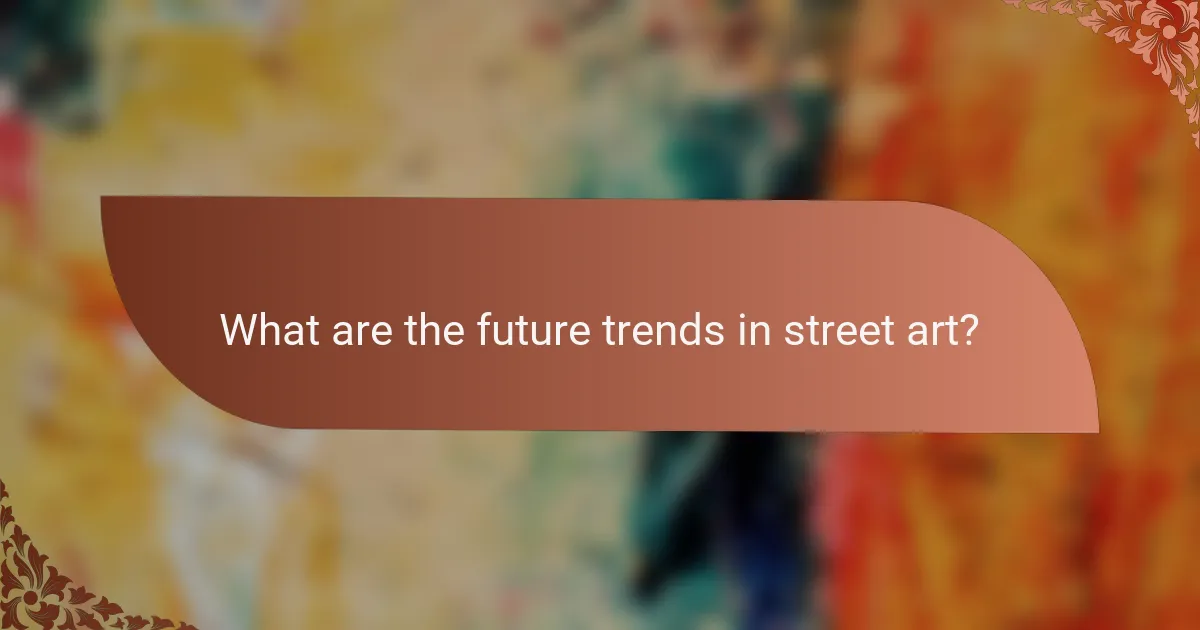
What are the future trends in street art?
Future trends in street art include increased digital integration, community engagement, and environmental awareness. Artists are using augmented reality to enhance their work, creating interactive experiences. Collaborations with local communities are fostering social messages and inclusivity. Additionally, sustainable practices are emerging, with artists using eco-friendly materials and techniques. These trends reflect a shift towards a more participatory and conscious form of expression in urban spaces.
How are environmental issues being addressed through street art?
Street art addresses environmental issues by raising awareness and inspiring action. Artists use public spaces to communicate messages about climate change, pollution, and conservation. Many murals depict nature, endangered species, or environmental disasters, creating a visual dialogue. This form of expression engages communities, encouraging them to reflect on their relationship with the environment and take action. Additionally, street art often utilizes sustainable materials and techniques, further promoting eco-friendly practices.
What role do social media platforms play in promoting street art?
Social media platforms significantly enhance the visibility and reach of street art. They allow artists to showcase their work to a global audience, fostering community engagement and appreciation. Platforms like Instagram and Facebook enable artists to share images, videos, and stories, which can go viral, attracting attention to their art and the cultural messages behind it. Additionally, social media facilitates collaboration among artists, curators, and fans, creating a dynamic ecosystem that supports the evolution of street art. The interactive nature of these platforms encourages dialogue and feedback, further enriching the cultural significance of street art in contemporary society.
What best practices can emerging street artists follow for success?
Emerging street artists can succeed by focusing on authenticity, community engagement, and continuous skill development. Building a unique style that connects with local culture enhances visibility. Networking with other artists and participating in collaborative projects fosters support and exposure. Utilizing social media effectively showcases work and attracts a broader audience. Lastly, understanding legalities around public art ensures sustainable practices.
